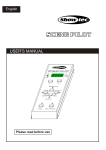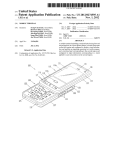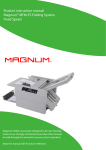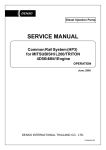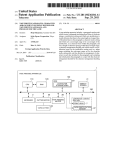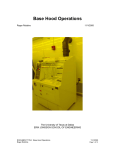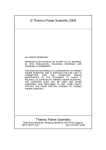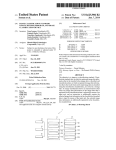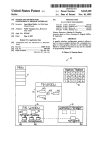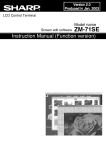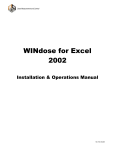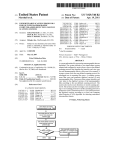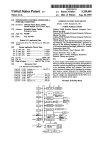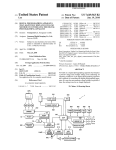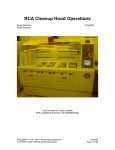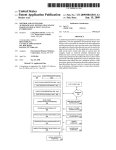Download Image forming device, a failure prediction method executed by an
Transcript
US 20100322640A1 (19) United States (12) Patent Application Publication (10) Pub. No.: US 2010/0322640 A1 Yamada (43) Pub. Date: (54) IMAGE FORMING DEVICE, A FAILURE (30) Dec. 23, 2010 Foreign Application Priority Data PREDICTION METHOD EXECUTED BY AN IMAGE FORMING DEVICE, AND A Jun. 19, 2009 COMPUTER READABLE STORAGE MEDIUM STORING A PROGRAM FOR CONTROLLING AN IMAGE FORMING DEVICE (JP) ............................... .. 2009-146816 Publication Classi?cation (51) Int- Cl (52) us. Cl. ........................................................ .. 399/11 G03G 15/00 _ (75) Inventor: _ Kei Yamada, Atsug1-sh1 (JP) (57) (2006.01) ABSTRACT Correspondence Address: The image forming device according to the present invention BUCHANAN, INGERSOLL & ROONEY PC POST OFFICE BOX 1404 capacity storage device is provided. The image forming can making accurate failure prediction Without using a high device has a detecting unit for detecting certain abnormality Which portends a breakdown of the image forming device ALEXANDRIA, VA 22313-1404 (US) (73) Assignee: itself, an instructing unit for instructing user about an opera tion test on the region Where the abnormality has been KONICA MINOLTA BUSINESS detected by the detecting unit (S201), a testing unit for per forming the operation test on the region With assistance of the TECHNOLOGIES, INC., Chiyoda-ku (JP) user Who has been instructed by the instructing unit (S203), a (21) Appl. No.: 12/817,402 measuring unit for measuring values describing the current status of the region during the operation test by the testing unit (S204), and a predicting unit for conducting the failure pre (22) Filed: Jun. 17, 2010 measuring unit (S205). diction on the region based on the valued measured by the Failure prediction Start S1 01 Paper jam detected? S102 Store sensor data 8103 Spot paperjam occurrence region 8104 Download suitable script S105 action completed? S106 Script execution l Recovery Patent Application Publication Dec. 23, 2010 Sheet 1 of 10 US 2010/0322640 A1 F|G.1 E 4 5 2 2 Remote control system xternal server N 2 PC MFP --------------- 1 3 '\ A 2 H62 1 11 \ / 14 Control unit Input unit Storage unit Network interface 12 \ f 15 13 \ Display unit \16 Patent Application Publication Dec. 23, 2010 Sheet 2 0f 10 US 2010/0322640 A1 2 21 \ . Control umt Image scanning unlt Storage unit Printing unit Operating unit Network interface 23 \ / 24 f 26 Patent Application Publication Dec. 23, 2010 Sheet 3 0f 10 FIG-.4 Failure prediction Start S101 S102 Store sensor data S103 Spot paper jam occurrence region S104 Download suitable script S105 action completed? Recovery YES S106 Script execution End US 2010/0322640 A1 Patent Application Publication Dec. 23, 2010 Sheet 4 0f 10 US 2010/0322640 A1 Script execution (S106) S201 Instruct user about preparation work for paper feeding test 3202 Preparation work completed? YES 8203 Perform paper feeding test S204 Store sensor data S205 Conduct failure prediction based on sensor data High failure 8206 NO probability? YES 8207 Send information to remote control system S208 Determine restricted function S209 Set restriction ?ag ( Return ) Patent Application Publication Dec. 23, 2010 Sheet 5 0f 10 US 2010/0322640 A1 Function restriction Start S301 Obtain function restriction ?ag 3302 Any restricted function? S303 Display warning message S304 Receive copying instruction Restricted function selected? 5306 Display warning message S307 Proceeding with copying? YES S308 Start copying End NO Patent Application Publication Dec. 23, 2010 Sheet 6 0f 10 US 2010/0322640 A1 Function restriction Start S401 Obtain restricted function flag NO S402 Any restricted“? YES S403 Display warning message S404 Receive print instruction Restricted function selected? S406 Displays warning message S407 Continue printing? YES S408 Order MFP to start printing End Patent Application Publication Dec. 23, 2010 Sheet 7 0f 10 US 2010/0322640 A1 $58V660532 . o2 558*2>981 mmRQ“o?m éelaog Patent Application Publication Dec. 23, 2010 Sheet 8 0f 10 US 2010/0322640 A1 858625:2 2622%he_89$\Q:.532§8>%9 22525%2%825m $vm moaoa 502 Patent Application Publication Dec. 23, 2010 Sheet 10 0f 10 5 23E25%N95A US 2010/0322640 A1 5£3895 A013A365% CcQ2AG6Ew5 cE52:065 N“E:$228A 3 sm85t:wql .56AAm55Aic6o8;tm%q 3%5mg8@:98390 NE298m85:38 AW A2 N@A:92:528 2 6E .@5 85 :5QG6Ew5Q S958a5uce CNmHA8EI9oEt2m8Q AugEEmma2%2652 US 2010/0322640 A1 IMAGE FORMING DEVICE, A FAILURE PREDICTION METHOD EXECUTED BY AN IMAGE FORMING DEVICE, AND A COMPUTER READABLE STORAGE MEDIUM STORING A PROGRAM FOR CONTROLLING AN IMAGE FORMING DEVICE Dec. 23, 2010 the region Where the abnormality has been detected by the detecting unit. The testing unit performs the operation test on the region With assistance of the user Who has been instructed by the instructing unit. The measuring unit measures values Which describe the current status of the region during the operation test by the testing unit. Finally, the predicting unit makes failure prediction on the region based on the values CROSS-REFERENCE TO RELATED APPLICATION [0001] This application is based on Japanese Patent Appli cation No. 2009- 1 468 1 6, ?led on Jun. 19, 2009, the contents of Which are incorporated herein by reference. BACKGROUND [0002] 1. Technical Field [0003] The present invention relates to an image forming device that is capable of making failure prediction on its various regions, a failure prediction method executed by the measured by the measuring unit. [0011] Preferably, the image forming device further com prises a ?rst communication unit for doWnloading a failure prediction program from an external server, and the predict ing unit makes the failure prediction using the program doWn loaded by the ?rst communication unit. [0012] Preferably, the ?rst communication unit selectively doWnloads the failure prediction program according to the type of the abnormality detected by the detecting unit. [0013] Preferably, the image forming device further com prises a display unit for displaying the result of the failure prediction by the predicting unit. Preferably, the display unit image forming device, and a computer-readable recording forms apart of an operation panel of the image forming medium storing a control program for the image forming device. device. [0014] Preferably, the image forming device further com prises a function restriction determining unit for determining function restriction to be imposed on the image forming device, from the result of the failure prediction by the pre dicting unit, and the operation panel displays information on the function restriction determined by the function restriction [0004] [0005] 2. Description of RelatedArt In recent years, MFP’s improved performance enabled its shared use by many users, and thereby resulted in reduction of its introduction cost. HoWever, such shared use of a MFP could possibly cause all the users a lot of trouble if the MFP stops operation due to a failure. Hence there is high demand for failure prediction technologies Which alloW for an accurate prediction of the time When failures is likely to occur in a MFP, so that it can be properly maintained or repaired before breaking doWn. [0006] Previously, the most commonly-used method of determining unit. [0015] Preferably, the operation panel displays a Warning message for advising user not to use the function affected by the function restriction determined by the function restriction determining unit if it is selected by user. [0016] Preferably, the image forming device further com MFP’s failure prediction Was to store a set of data measured by sensors installed in various regions Within a MFP into a prises a second communication unit for sending information on the function restriction determined by the function restric high-capacity storage device like a hard disk, and statistically analyZe chronological change in the measured data. For example, the Japanese Unexamined Publication No. 2007 tion determining unit, to a printer driver for con?guring print settings of the image forming device, so that the printer driver 256356 discloses a failure prediction method Which includes can display information on the function restriction on its print setting screen. calculating an abnormality index value for the most-recently [0017] acquired data set from normal data sets stored in a hard disk, Which have been obtained at certain intervals. diction based on the values measured at the time When the [0007] HoWever, the conventional technology described Preferably, the predicting unit makes the failure pre abnormality has been detected by the detecting unit. [0018] Preferably, the image forming device further com above has a defect in its high introduction cost due to the prises a third communication unit for sending information on necessity for a high-capacity hard disk. Moreover, this tech the result of the failure prediction by the predicting unit, to an external control system. [0019] The objects, features, and characteristics of this nology only involves periodical acquisition of normal data, and hence it does not make use of abnormal data correspond ing to MFP’s malfunctions like a paper jam Which portend a MFP failure although analysis of such abnormal data are knoWn to be effective in accurate failure prediction. [0008] The present invention is intended to solve the above mentioned problems in the prior art, and its object is to pro vide an image forming device capable of highly-accurate failure prediction Without the necessity for a high-capacity storage device. SUMMARY [0009] To achieve at least one of the above-mentioned objects, an image forming device re?ecting an aspect of the present invention comprises a detecting unit, an instructing unit, a testing unit, a measuring unit, predicting unit. [0010] The detecting unit detects certain abnormality Which portends a breakdoWn of the image forming device. The instructing unit instructs user about an operation test on invention other than those set forth above Will become appar ent from the description given beloW With reference to pre ferred embodiments illustrated in the accompanying draW mgs. BRIEF DESCRIPTION OF THE DRAWINGS [0020] FIG. 1 is a block diagram shoWing an exemplary structure of the failure prediction system including the image forming device according to one embodiment of the present invention. [0021] FIG. 2 is a block diagram shoWing an exemplary structure of the PC shoWn in FIG. 1. [0022] FIG. 3 is a block diagram shoWing an exemplary structure of the MFP shoWn in FIG. 1. [0023] FIG. 4 is a ?owchart shoWing exemplary steps of the failure prediction according to one ?rst embodiment of the present invention. US 2010/0322640 A1 Dec. 23,2010 for controlling PC 1’s basic operations, a RAM for tempo [0024] FIG. 5 is a ?owchart showing exemplary steps of the script execution according to one embodiment of the present invention. [0025] FIG. 6 is a ?owchart showing exemplary steps for the function restriction for the copying function according to rarily storing control programs to serve as a working area, and a hard disk for storing an OS (operating system or basic software) as well as control programs and parameters for one embodiment of the present invention. The hard disk of the storage unit 12 particularly stores various [0026] FIG. 7 is a ?owchart showing exemplary steps for the function restriction for the print function according to one embodiment of the present invention. [0027] FIG. 8 is a schematic view of the copying setting UI applications for producing document ?les, and a printer driver for con?guring MFP 2’s print function. screen according to an embodiment of the present invention. kinds of information to the user who tries to operates the PC [0028] 1. The display unit 13 particularly displays an UI (User Inter face) screen for print settings, which is offered by the afore FIG. 9 is a schematic view of the copying setting UI screen according to one embodiment of the present invention. [0029] FIG. 10 is a schematic view of the print setting UI screen according to one embodiment of the present invention. [0030] FIG. 11 is a schematic view for illustrating the advantageous effects according to one embodiment of the present invention. DETAILED DESCRIPTION [0031] The embodiment of this invention is described below with reference to the accompanying drawings. <System Structure> [0032] FIG. 1 is a block diagram showing an exemplary structure of a failure prediction system in which an MFP 2 serves as an image forming device according to the embodi ment of the present invention. As shown in FIG. 1, the failure prediction system according to the embodiment includes an image forming system A, an external server 4, and a remote control system 5, all of which are connected one another via a network N so that they are capable of interactive commu nications. The network N can be a public communication network such as ISDN or CATV, a computer network such as controlling PC 1’s speci?c operations to be described later. [0037] The display unit 13 is a display device such as a CRT display and a liquid crystal display, and displays various mentioned printer driver. FIG. 9 is an schematic view of the print setting UI screen “u”. [0038] The input unit 14 includes a keyboard and a mouse for acquiring various instructions from user. The communi cation interface 15 is an interface for communicating with the MFP 2 via the LAN 3, and is typically a network interface to a standard such as Ethernet®, TokenRing, and FDDI, a serial interface such as USB and IEEE 1394, a parallel interface such as SCSI and IEEE 1284, etc. [0039] FIG. 3 is a block diagram showing an exemplary structure of the MFP 2. As shown in FIG. 3, the MFP 2 includes a control unit 21, a storage unit 22, an operating unit 23, an image scanning unit 24, a printing unit 25, and a communication interface 26, all of which are interconnected via a bus 27 for exchanging signals. These elements are be described in details below. [0040] The control unit 21 is a CPU for not only performing various calculations, but also controlling each of the elements according to various control programs. The storage unit 22 includes a ROM for storing control programs and parameters, a RAM for temporarily storing control programs to serve as a working area, and a hard disk for storing an OS (operating LAN, WAN and Internet, or a dedicated circuit to be used system or basic software) as well as control programs and exclusively by users of the system. [0033] As shown in FIG. 1, the image forming system A parameters for controlling MFP 2’s speci?c operations as includes a PC 1 which serves as a client device, and the MFP described later. [0041] The operating unit 23 includes a touch panel which is capable of not only displaying MFP 2’s status and various 2 which serves as an image forming device having functions to print the data received from the PC 1 and to copy various documents, and they are connected with each other by a LAN kinds of setting information, but also receiving various 3 for their interactive communications. The image forming includes various ?xed keys such as ten-keys for receiving the system A is connected to the network N via the LAN 3. The number of copies, Start & Stop keys for receiving instructions LAN 3 includes a router, a proxy server, and other commu to start and stop operations, and a Reset key for receiving an instruction to initialiZe the settings as well various display nication devices for relaying data exchange between the image forming system A and various other devices on the network N although they are not shown in the ?gures. [0034] An exemplary structure of each device is described in detail below while each device may also include any other constituents than those described below, or only include part of the constituents described below. Descriptions of any func tions common to more than one device will be made only once, and will not be repeated to avoid redundancy. [0035] FIG. 2 is a block diagram showing en exemplary structure of the PC 1. As shown in FIG. 2, the PC 1 includes a control unit 11, a storage unit 12, a display unit 13, an input unit 14, and a communication interface 15, all of which are interconnected via a bus 16 for exchanging signals. These elements will be described in detail below. [0036] The control unit 11 is a CPU for not only performing various calculations, but also controlling each of the elements according to various control programs. The storage unit 12 includes a ROM for storing control programs and parameters instructions from user. The operating unit 23 may further lamps. In particular, the touch panel of the operating unit 23 displays a copying setting UI screen U for con?guring MFP 2’s copying function. FIG. 8 and FIG. 9 each shows schematic view of the copying setting UI screen “u”. [0042] What is shown in FIG. 8 is an initial status of the setting screen which appears on MFP 2’s start-up, and this initial screen is replaced by an advanced setting screen shown in FIG. 9 when the "Double-side/Combination” icon in FIG. 8 is clicked. [0043] The image scanning unit 24 performs the scanning which comprises irradiating by a light source like a ?uores cent lamp, a document placed on a certain location on a document table or transported to the location by an ADF (Auto Document Feeder) with a light source like a ?uorescent lamp, converting the scanned image into electrical signals by means of a light sensing element like a CCD image sensor and a CMOS image sensor to generate image data (bitmap data) for printing. US 2010/0322640 A1 Dec. 23, 2010 sensors along its paper path, and these sensors measure the involved in the transportation of copy/printing paper within the MFP 2 (hereinafter referred to generically as “transport time of document passage through their locations. The feed unit”). roller for transporting documents is provided with rotary encoders. The data measured by the sensors and encoders is used for the failure detection of the MFP 2 as described later. [0051] FIG. 4 is a ?owchart showing exemplary steps of MFP 2’s failure prediction according to the embodiment. The algorithm shown in the ?owchart of FIG. 4 is stored in the [0045] The print unit 25 prints on printing paper an image based on the image data generated by the image scanning unit ROM as a control program, and is read out to be executed by the CPU when the program starts. 24 or received from the PC 1 using the electro-photographic technology. More speci?cally, the printing unit 25 forms an image on the printing paper by a method having a charging step for electrically charging a sensitiZer drum, an exposing step for exposing a static latent image on the sensitiZer drum by means of laser beam, a developing step for forming a toner image by applying toner to the electrostatic latent image on the sensitiZer drum, a transferring step for transferring the toner image on the sensitiZer drum to the printing paper by [0052] Firstly, the MFP 2 waits to detect any abnormality that portends a failure of the MFP 2 (S101: No). More spe ci?cally, the MFP 2 of the present embodiment waits to detect paper jam as it portends a failure in the transport unit. The paper jam detection method employed by the MFP 2 of the present embodiment includes, but not limited to, a method with a step of detecting any copy/printing paper that is retained in the paper path for a certain period of time, using [0044] The ADF is provided with a plurality of optical means of a transfer belt, and a ?xing step for heating the toner image on the printing paper to ?x it thereto. the aforementioned sensors. [0053] Once paperjam is detected (s101: Yes), the MFP 2 optical sensors along its paper path, and these sensors mea sure the time of paper passage through their locations. Each of stores data on the time of the latest paper passage measured by each sensor into the storage unit 22 (S102). The data stored in this step is hereinafter referred to as “?rst sensor data”. The MFP 2 then analyZes the ?rst sensor data to spot the region the rotary members like the sensitiZer drum, the transfer belt where the paper jam occurred (S103). More speci?cally, the drive roller, and the ?xing roller is provided with rotary MFP 2 localiZes the sensor which detected abnormal passage time at the time when the paper jam was detected, and recog niZes the vicinity of the sensor as the paper jam occurrence [0046] The printing unit 25 is provided with a plurality of encoders. The data measured by these sensors and the rotary encoders is also used for the failure detection of the MFP 2 as described later. [0047] The communication interface 26 is an interface for communicating with the PC 1 via the LAN 3, and is typically a network interface to a standard such as Ethemet®, Token Ring, and FDDI, a serial interface such as USB and IEEE 1394, a parallel interface such as SCSI and IEEE 1284, etc. [0048] Referring to FIG. 1 again, the external server 4 is a ?le server capable of storing and transferring various ?les. The external server 4 stores a set of programs for making failure prediction on various regions of the MFP 2 based on the data measured by the aforementioned sensors and encod ers, and it transfers these programs to the MFP 2 in response to a request from it. These programs are hereinafter referred to as “scripts” as they are normally written in script languages. Each of the scripts stored in the external server 4 is suitable to failure prediction on a certain region of the MFP 2, and the MFP 2 can download the optimum script according to its current status. Moreover, the scripts in the external server 4 can be continually updated based on their performance records which are available on the market, so that the MFP 2 can download the latest version of the script for obtaining the most accurate failure prediction result. [0049] Referring to FIG. 1 again, the remote control system 5 of the present embodiment is a computer system capable of monitoring the operating status of the MFP 2 from a remote location via the network N, and executing maintenance con trol of the MFP 2. The remote control system 4 is also capable of issuing an order to dispatch a serviceman to MFP 2’s location upon receiving a notice which is sent by the MFP 2 when the failure prediction results in a high chance of failure occurrence. This allows the dispatched serviceman to repair or maintain the MFP 2 before actual failure occurrence. <Flowchart> region. [0054] This is how the MFP 2 spot the paper jam occur rence region, but it is still unclear whether the paper jam occurrence should be ascribed to an accidental event like erroneous paper feeding, or to a permanent event like wear out or malfunction of the machine components. Therefore, the MFP 2 conducts more advanced failure prediction using a downloaded script which accompanies an operation test on the paper jam occurrence region as detailed below. [0055] Next, the MFP 2 communicates with the external server 4 via the network N to download the failure prediction script for the paper jam occurrence region spotted in step S103 (S104). For example, the MFP 2 downloads a failure prediction script for the ADF if the paper jam occurrence region spotted in step S103 turns out to be the ADF. As such, the MFP 2 downloads the most suitable script to the current status of the faulty region among those stored in the external server 4. [0056] Next, the MFP 2 waits for completion of user’s recovery action on the paper jam (S105: No). As soon as the user completes the recovery action (S105: Yes), the MFP 2 executes the downloaded script in step S104 (S106) for the paper jam occurrence region, to ?nish the series of steps (End). Details of the script execution in step S106 are described below. The method employed by the MFP 2 of the present embodiment for determining whether user’s recovery action has been completed includes but not limited to a method with a step of receiving user’s key operation to indi cate the completion through the operating unit 23. [0057] Next, details of the script execution in step S106 are described below with reference to FIG. 5. Firstly, the MFP 2 prompts user to carry out preparation work for the operation test on the abnormality occurrence region (S201), which is also a subject of the subsequent failure prediction. More speci?cally, the MFP 2 in this example prompts user to carry [0050] Details of the failure prediction by the MFP 2 according to the present embodiment are given below with reference to the ?owchart. The following example shows the out preparation work for the paper feeding test on the paper jam occurrence region. The paper feeding test herein means a failure prediction on MFP 2’s machine components which are test involving forced paper feeding through the paper jam US 2010/0322640 A1 Dec. 23, 2010 occurrence region (e.g., ADF), and the preparation Work for “double-side printing”, Which involves operation of the ADF, this test herein means user’s manual Work to set printing paper on the paper feed tray of the ADF. The aforementioned prepa as restricted function, if the paper j am occurrence region is the ADF. [0064] Finally, the MFP 2 sets a function restriction ?ag for ration Work Won’t cause the user much trouble as the user is supposed to stay close to the MFP 2 after the recovery action on the paperjam. [0058] Next, the MFP 2 Waits for completion of user’s preparation Work in response to the instruction in step S201 (S202: No), and then starts the paper feeding test on the paper jam occurrence region (S203) upon completion of the prepa ration Work (s202:Yes). The MFP 2 then measures the time of paper passage by each sensor, and stores the data into the storage units (S204). The data stored in this step is hereinafter the restricted function determined in step S208, in the storage area 22 (S209), before ?nishing the series of steps (Return). The MFP 2 preferably gets rebooted upon completion of the script execution, but the ?ag set in step S209 remains held in the storage unit 22 after the reboot as it is a nonvolatile ?ag. After the reboot, the MFP 2 refers to the ?ag to establish the relevant function restriction on itself. The steps of the func tion restriction are described in detail beloW. [0059] The MFP 2 conducts the failure prediction on the paper jam occurrence region based on the ?rst and second [0065] FIG. 6 is a ?owchart shoWing exemplary steps of the function restriction executed by the MFP 2 upon the reboot after the script execution. The MFP 2 ?rstly reads out the ?ag set in step S209 from the storage unit 22 (S301) in order to judge Whether or not there is any restricted function (3302). sensor data (S205). The failure prediction method employed The MFP 2 moves to step S304 if there is no restricted by the MFP 2 in this example includes but not limited to a function (S302: No). On the other hand, if there is any restricted function (S302: Yes), the MFP 2 displays a Warning referred to as “second sensor data”, in comparison to the “?rst sensor data” mentioned above. method having steps of calculating an abnormal index value for the ?rst and second sensor data by multivariable analysis, message advising user not to use the restricted function and evaluate a failure probability of the paper jam occurrence region based on the calculation result. The abnormality index (S303). For example, the MFP 2 displays the Warning mes can typically be the Maharanobis’ generaliZed distance copying setting Ul screen U in the operating unit 23 if the restricted function turns out to double-side printing (refer to betWeen the ?rst/ second sensor data and a pre-established normal data group. There has to be a predetermined correla tion betWeen calculation of abnormality index values like the Maharanobis’ distance and failure probability values of indi vidual paper occurrence regions. [0060] As canbe seen from the above, more accurate failure prediction result can be achieved by utiliZing the sensor data sage: “Please don’t use the double-side printing unit.” on the FIG. 8). [0066] Upon receiving user’s instruction to start the copy ing (S304), the MFP 2 judges Whether or not the copying settings con?gured on the UI screen U includes selection of any restricted function (S305), and splits the rest of the steps according to the judgment result. More speci?cally, the MFP obtained during the operation test (e.g., paper feeding test) Which immediately folloWs the abnormality (paper jam) 2 asks for user’s ?nal con?rmation as to Whether or not it occurrence. the prediction accuracy can also be improved by using the measured data by the rotary encoders attached to ing message to alloW him/her to have a second thought (S306) various rotating members including the ADF feed roller, the sensitiZer drum, the transfer belt drive roller, and the ?xing roller although the MFP 2 in this example only uses data measure by the optical sensors installed along the paper path for copy/printing paper. [0061] Next, the MFP 2 splits the rest of the steps according to the failure prediction result in step S205 (S206). More speci?cally, the MFP 2 ?nishes (End) the series of steps if the failure probability evaluated in step S205 turns out to be beloW a certain level (S206: No). On the other hand, the MFP 2 proceeds to step S207 if the failure probability evaluated in should proceed With the copying by displaying another Wam if the copying settings include any restricted function (S305: Yes). On the other hand, the MFP 2 immediately starts the copying (S308) if the copying settings do not include any restricted function (S305: No). For example, the MFP 2 sWitches the UI screen U to the one as shoWn in FIG. 8, and displays the further Warning message: “Please don’t use the double-side printing unit” if the user has de?ed the Warning as shoWn in FIG. 7 and selected the icon: “Double-side/Combi nation”. [0067] The MFP 2 then starts the copying (S308) to ?nish the series of steps (End) if it receives an instruction to proceed With the copying (S307: Yes) i.e. if either the button: “Single (S206: Yes). side:>Double-side” or the button: “Double-side:>Double side” has been selected on the UI screen shoWn in FIG. 8. On [0062] In step S207, the MFP 2 noti?es the remote control system 5 of the failure prediction result in step S205 via the netWork N. Upon receiving that notice, the remote control the other hand, the MFP 2 ?nishes the series of steps (End) Without proceeding With the copying if it receives an instruc tion not to proceed With the copying (S307: No) i.e. if the system 5 transmits a service instruction to a terminal device carried by a serviceman by email. Upon receiving that service button: “Cancel” is selected on the UI screen shoWn in FIG. 8. [0068] Such function restriction as described above ensures instruction, the serviceman Will move rapidly to the location of the MFP 2 to perform repair or maintenance on the paper that unfavorable use of the abnormality occurrence region like paper j am can be avoided, and thereby minimizing doWn jam occurrence region. [0063] In the meantime, certain function restriction should time of the MFP 2 as a Whole. The function restriction accord be imposed on the MFP 2 until serviceman’s arrival. This is to ensure that the paper jam occurrence region Will not be oper determines the function of the MFP 2 Which involves opera 2’s copying function as described in FIG. 6, but also to its print function Which can be utiliZed via the PC 1. The function restriction for MFP 2’s print function is described in details beloW. tion of the paper jam occurrence region (S208). The function subject to the function restriction is hereinafter called “restricted function”. For example, the MFP 2 determines [0069] FIG. 7 is a ?owchart shoWing exemplary steps of the function restriction executed by PC 1’s printer driver upon completion of the script execution as shoWn in FIG. 5. The step S205 turns out to be equal to or above a certain level ated until it is ?xed by the serviceman. Therefore, the MFP 2 ing to the present embodiment is applicable not only to MFP US 2010/0322640 A1 algorithm shown in this ?owchart is stored in the ROM as a control program, and is read out to be executed by the CPU when the program starts. [0070] The PC 1 ?rstly communicates with the MFP 2 via the network N in order to obtain the ?ag retained in the storage unit 22 (S401). The PC 1 then judges whether or not there is any restricted function based on the ?ag obtained in step S401 (S402), and moves directly to step S404 if there is no restricted function (S402: No). On the other hand, if there is any restricted function (S402: Yes), the PC 1 displays a warning message advising user not to use the restricted func Dec. 23, 2010 More speci?cally, the MFP 2 displays a warning message advising user not to use the restricted function (e.g., double side printing) on the copying setting Ul screen “U”. [0080] (g) The PC 1 establishes the function restriction on the printing function based on the ?ag obtained from the MFP 2. More speci?cally, the PC 1 displays a warning message advising user not to use the restricted function (e.g., double side printing) on the print setting Ul screen “u”. [0081] (h) The MFP 2 sends the failure prediction result to the remote control system 5. Upon receiving the report, the tion (S403). For example, the PC 1 displays the warning remote control system 5 arranges for a serviceman dispatch. [0082] As can be seen from the steps (a) and (b), the MFP 2 message: “Please don’t use this function.” on the print setting Ul screen u on the display unit 13 (refer to FIG. 10). according to the present embodiment selectively downloads the most suitable failure prediction script to the abnormality [0071] Upon receiving user’s instruction to start printing (S404), the PC 1 judges whether or not the print settings occurrence region such as paper jam occurrence region. As such, this embodiment allows for reduced network load on the network N during the script downloading as well as reduced con?gured on the UI screen u includes selection of any restricted function (S405), and splits the rest of the steps according to the judgment result. More speci?cally, the MFP processing load on the MFP 2 during the failure prediction. Furthermore, the present embodiment can achieve to more 2 asks for user’s ?nal con?rmation as to whether or not it accurate prediction result by continually updating the scripts should proceed with the printing by displaying another wam on the external server 4 based on their performance records available on the market. ing message to allow him/her to have a second thought (S406) if the print settings include any restricted function (S405: Yes). On the other hand, the PC 1 immediately orders the MFP 2 to start the printing (S408) if the print settings do not include the restricted function. For example, the PC 1 dis plays a pop-up with the warning message: “Use of double this embodiment eliminates the need to accumulate normal side printing unit may cause a technical trouble. Continue?” as shown in FIG. 10. operation data in advance, and thereby achieving accurate failure prediction result without a high-capacity storage unit. [0072] Furthermore, the present embodiment doesn’t put user to much trouble with the preparation work for the operation test The PC 1 then orders the MFP 2 to start the printing (S408) before ?nishing the series of steps (End) if receives an instruction to continue the printing (S407: Yes) i.e. if the [0083] As can be seen from (c) and (d) above, the MFP 2 according to the present embodiment conducts the failure predictions based on the sensor data measured during the operation test on the abnormality occurrence region. Thus, button: “Yes” is selected on the pop-up in FIG. 10. On the as all he/ she should do is to proceed to the preparatory work after ?nishing the recovery action on the on the paper jam other hand, the PC 1 ?nishes the series of steps (End) without occurrence region by following the instruction on the copying ordering the MFP 2 to start the printing if it receives an setting Ul screen U. instruction not to continue the printing (S407: No) i.e. if the button: “No” is selected on the pop-up in FIG. 10. [0084] As can be seen from the steps (e) to (h) above, the MFP 2 and the PC 1 (printer driver) according to the present [0073] embodiment con?gure proper function restriction on MFP 2’s The advantageous effects of the present embodi ment are described below in detail. The failure prediction system with the MFP 2 of the present embodiment as a whole serves to conduct the failure prediction on the MFP 2 in the followings steps (a) to (f): copying and print functions based on the failure prediction result. Therefore, the present embodiment can effectively prevent a breakdown of the entire MFP 2, which can be [0074] (a) When paper jam is detected, the MFP 2 localiZes the abnormality occurrence region (e.g., ADF) based on the caused by excessive use of the abnormality occurrence region (e.g., ADF) before arrival of a serviceman. In other words, the present embodiment can minimiZe MFP 2’s possible down sensor data. time, and thereby enhancing its user-friendliness. [0075] (b) The MFP 2 downloads from the external server 4 the most suitable script to the localiZed paper jam occurrence [0085] The invention is not limited to the embodiment described above, and hence it can be modi?ed within the region. [0076] (c) User performs the preparation work for the operation test on the paper jam occurrence region according to the instruction on the UI screen U, after ?nishing the recovery action on the region. For example, user sets printing paper in a paper feeding tray of the ADF if the paper jam occurrence region turns out to be the ADF. [0077] (d) The MFP 2 causes its sensors to measure data on scope of the appended claims. For example, the system of the present embodiment starts executing the failure prediction script when its sensors detect certain abnormality (e. g., paper jam) in the transport unit, but the present invention is not limited to this. For example, the system of the present inven tion can also cause its various units including the transfer and ?xing units to record the accumulated number of counts rep resenting their operational status, and regards excessive the paper passage time during its operation test on the paper counts beyond a certain threshold level as abnormality occur jam occurrence region. [0078] (e) The MFP 2 conducts the failure prediction on the rence which should trigger the script execution. paper jam occurrence region based on the sensor data mea tion can be implemented as a dedicated hardware circuit for executing each of the above-mentioned steps, or a program sured during the operation test, and sets the function restric tion ?ag in the storage unit 22 corresponding to the failure prediction result. [0079] (f) The MFP 2 establishes the function restriction on its copying function based on the ?ag in the storage unit 22. [0086] The image forming device according to this inven executed by a CPU to perform the aforementioned steps. If the present invention is implemented as the latter, the pro grams for driving the image forming device can be offered in the form of a computer-readable recording media such as a US 2010/0322640 A1 ?oppy® disk and a CD-ROM, or a doWnloadable ?le via a network like the Internet. The program recorded in a com puter readable recording medium is normally transferred to a ROM, hard disk or other memory devices. The program can also be offered in the form of an independent application softWare, or can be built into a softWare of the image process ing device to serve one of its functions. What is claimed is: Dec. 23, 2010 tion on the result of said failure prediction by said predicting unit, to an external control system. 11. A failure prediction method to be executed by an image forming device comprising the steps of: (A) detecting certain abnormality Which portends a break doWn of said image forming device; (B) instructing user about an operation test on the region device Where said abnormality has been detected in step (A); 1. An image forming device comprising: (C) performing the operation test on said region With assis a detecting unit for detecting certain abnormality Which portends a breakdoWn of said image forming device; (D) measuring values describing the current status of said an instructing unit for instructing user about an operation test on the region Where said abnormality has been detected by said detecting unit; a testing unit for performing the operation test on said region With assistance of the user Who has been instructed by said instructing unit; a measuring unit for measuring values Which describe the current status of said region during said operation test by said testing unit; and tance of user Who has been instructed in step (B); region during said operation test in step (C); and (E) making failure prediction for said region based on said values measured in said step (D). 12. The failure prediction method as claimed in claim 11 further comprising the step of (a) doWnloading a failure pre diction program from an external server, Wherein in said step (D) said failure prediction is made using said failure predic tion program doWnloaded in said step (a). 13. The failure prediction method as claimed in claim 12, Wherein, in said step (a), said failure prediction program is selectively doWnloaded according to the type of said abnor a predicting unit for making failure prediction on said region based on said values measured by said measuring unit. 2. The image forming device as claimed in claim 1 further comprising a ?rst communication unit for doWnloading a failure prediction program from an external server, Wherein 15. The failure prediction method as claimed in claim 14, Wherein said display unit forms a part of an operation panel of said predicting unit makes said failure prediction using said said image forming device. failure prediction program doWnloaded by said ?rst commu nication unit. 3. The image forming device as claimed in claim 2, Wherein said ?rst communication unit selectively doWnloads said failure prediction program according to the type of said abnormality detected by said detecting unit. mality detected in said step (A). 14. The failure prediction method as claimed in claim 11 further comprising the steps of (b) displaying on a display unit, the result of said failure prediction made in said step (E). 16. The failure prediction method as claimed in claim 15 further comprising the steps of: (c) determining ?lnction restriction to be imposed on said image forming device, from the result of said failure prediction in said step (E); and (d) displaying on said operation panel, information on said function restriction determined in said step (c). 4. The image forming device as claimed in claim 1 further comprising a display unit for displaying the result of said further comprising the step of displaying on said operation failure prediction by said predicting unit. panel, a Warning message for advising user not to use the 5. The image forming device as claimed in claim 4, Wherein said display unit forms a part of an operation panel of function affected by said function restriction determined in said step (c) if it is selected by user. 18. The failure prediction method as claimed in claim 16 further comprising the step of sending information on said function restriction determined in said step (c) to a printer said image forming device. 6. The image forming device as claimed in claim 5 further comprising a function restriction determining unit for deter mining function restriction to be imposed on said image forming device, from the result of said failure prediction by said predicting unit, Wherein said operation panel displays information on said function restriction determined by said function restriction determining unit. 7. The image forming device as claimed in claim 6, Wherein said operation panel displays a Warning message for advising user not to use the function affected by said func tional restriction determined by said function restriction determining unit if it is selected by user. 8. The image forming device as claimed in claim 6 further comprising a second communication unit for sending infor mation on said function restriction determined by said func tion restriction determining unit, to a printer driver for con 17. The failure prediction method as claimed in claim 16 driver for con?guring print settings of said image forming device, so that said printer driver can display information on said functional restriction on its print setting screen. 19. The failure prediction method as claimed in claim 11, Wherein, in said step (E), said failure prediction is made based on said values measured at the time When said abnormality has been detected in said step (A). 20. The failure prediction method as claimed in claim 11 further comprising the step of sending information on the result of said failure prediction in said step (E), to an external control system. 21. A computer readable recording medium storing a pro gram causing an image forming device to execute the steps of: (A) detecting certain abnormality Which portends a break doWn of said image forming device; ?guring print settings of said image forming device, so that (B) instructing user about an operation test on the region said printer driver can display information on said function restriction on its print setting screen. 9. The image forming device as claimed in claim 1 (D) measuring values describing the current status of said Wherein, said predicting unit makes said failure prediction based on said values measured at the time When said abnor mality has been detected by said detecting unit. 10. The image forming device as claimed in claim 1 further comprising a third communication unit for sending informa Where said abnormality has been detected in step (A); (C) performing the operation test on said region With assis tance of user Who has been instructed in said step (B); region during said operation test in said step (C); and (E) making failure prediction for said region based on said values measured in said step (D). * * * * *

















